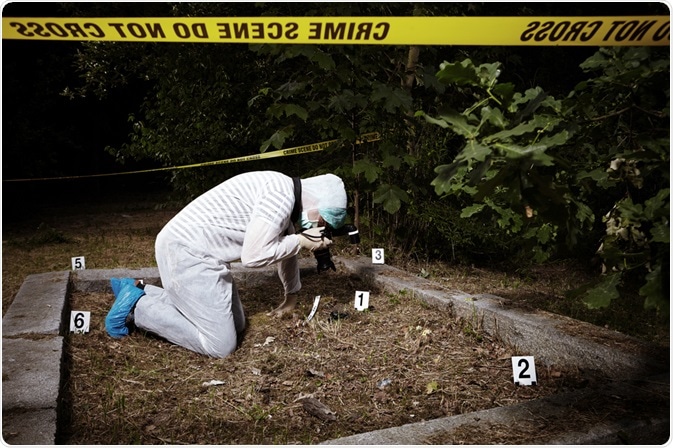What is infrared spectroscopy?
Infrared spectroscopy is the method of applying infrared radiation to a sample to uncover its various characteristics based on its absorption spectroscopy.

Image Credit: Couperfield/Shutterstock.com
The technique uses an infrared spectrometer to generate an infrared spectrum that is applied to a sample.
Molecules within a sample will absorb radiation frequencies that characteristic of their structure, and this information is presented in a graph where the absorbance of infrared light is represented in the y-axis and wavelength is represented in the x-axis.
This allows scientists to gain information on the identity and chemical composition of unknown solids, liquids, and gases by analyzing the infrared spectrum.
Infrared spectroscopy is also used to identify functional groups and structure of a sample, gain information on the progress of a chemical reaction, detect impurities, and perform quantitative analyses.
A wide range of industries has adopted infrared spectroscopy in several applications, from blood alcohol content analysis to determine alcohol levels of suspected drunk drivers to measuring carbon dioxide levels in the atmosphere.
One of its many applications is paint analysis, which is a vitally important tool in forensic labs as well as in art restoration.
Why is paint analysis important?
Paint fragments can be vital pieces of evidence retrieved from a crime scene. Paint chips from cars can help identify a vehicle involved in crimes such as hit and runs and even murder, they can also help to identify objects that were implicated in a crime, for example, if paint chips from objects used as a weapon may become apparent.
Also, paint chips can help link a person to a scene, for example, if chips were found in the clothes of an individual that match the scene of a crime, it can help implicate a suspect.
In forensic science, paint analysis can be used in a multitude of ways to help resolve a crime, and the evidence can come in many forms, including single layer or multilayered fragments, chips, smears, and small droplets.
Paint pigment analysis is also important in the restoration of paintings and ancient artifacts. It helps scientists identify how the painting or artifact was originally made, enabling them to recreate this process during its restoration to preserve its original features.
Infrared spectroscopy coupled with other techniques as a method of paint analysis
There can be multiple ways to analyze paint, given the fact that it is a piece of evidence that can provide a wealth of useful forensic case information. However, the main aim of paint analysis focusses on establishing the type and origin of the paint, as well as making comparisons between evidence samples collected from a suspect and those found at the scene of a crime.
Several distinct analytical methods are used by forensic labs depending on the specific goal of the analysis. Microspectrometric techniques are relied on to determine the chemical content of paint traces.
Raman spectroscopy is usually employed to detect the main pigments within a paint sample. Finally, the techniques of X-ray fluorescence, scanning electron microscopy, and energy-dispersive X-ray spectroscopy are brought in to uncover a paint sample’s elemental composition as well as to identify the inorganic pigments and extenders.
Studies have explored the efficacy of infrared spectroscopy in tandem with other techniques on paint analysis to determine the full potential of its application in this field.
Paint samples collected from several crime scenes were analyzed with various techniques. First by optical microscopy which was successful in determining the characteristics of the sample’s structure.
Next, infrared spectroscopy measurements were generated using a Fourier transform infrared spectrometer that was equipped with a water-cooled high-temperature ceramic source and a UMA 500 microscope and MCT detector.
Mid-infrared range infrared spectra were recorded at a resolution of 4cm. The infrared spectra were measured by the transmission technique.
Following this, samples were analyzed with Raman spectroscopy. Raman measurements were generated using a dispersive
Raman spectrometer coupled with a confocal microscope. A Peltier-cooled charged coupled device diode array detector along with a holographic grating was added to the spectrometer, which measured samples in situ.
The results showed that on its own, infrared spectroscopy was not sufficient in providing full information on the sample’s chemical content due to the low concentration of dyes or pigments existent within a paint trace sample making them insufficient for infrared detection. Tests with Raman spectroscopy, however, demonstrated its sensitivity in detecting low levels of organic pigments.
Overall, the research found that the two techniques are best used in tandem, as the techniques complement each other. It was emphasized that combining the techniques is potentially the best solution to providing a thorough and reliable analytical tool for the analysis of forensic paint samples.
While infrared spectroscopy is therefore useful in paint analysis, it is improved through coupling it with Raman spectroscopy to overcome its sensitivity limitation.
Sources:
- Lv, J., Zhang, W., Liu, S., Chen, R., Feng, J., Zhou, S. and Liu, Y. (2016). Analysis of 52 automotive coating samples for forensic purposes with Fourier transform infrared spectroscopy (FTIR) and Raman microscopy. Environmental Forensics, 17(1), pp.59-67. https://www.tandfonline.com/doi/abs/10.1080/15275922.2015.1091403
- Zięba-Palus, J. and Trzcińska, B. (2013). Application of Infrared and Raman Spectroscopy in Paint Trace Examination. Journal of Forensic Sciences, 58(5), pp.1359-1363. https://onlinelibrary.wiley.com/doi/abs/10.1111/1556-4029.12183
- Zięba-Palus, J., Michalska, A. and Wesełucha-Birczyńska, A. (2011). Characterization of paint samples by infrared and Raman spectroscopy for criminalistic purposes. Journal of Molecular Structure, 993(1-3), pp.134-141. https://ui.adsabs.harvard.edu/abs/2011JMoSt.993..134Z/abstract
Further Reading